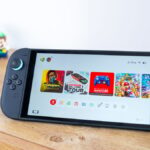It took the two biggest names in console gaming nearly a decade, but Sony and Microsoft finally seem to be learning the lesson Nintendo taught them ages ago. Handhelds are in season, and it seems Sony imagines its next big release will be a full-on portable PlayStation 5 (no, not that one). The real question is what it might be called, and if it will be released alongside a whole new console generation, namely the PlayStation 6.
We have our doubts Sony will suggest a necessarily lower-power handheld console will be a sequel to the PlayStation 5 and—especially—the more-powerful PS5 Pro. It may indicate Sony is anticipating a dual-release, with one console focused on performance and the other on portability. Either way, the little flecks of info falling out the grinding rumor mill suggest this upcoming console could be the side-grade we’ve been hoping for. A mobile PlayStation that can access your complete library of digital titles in a device you can slip into your backpack.
Late last year, reports from Bloomberg claimed Sony was hard at work on a handheld gaming device. There are still no details beyond the promise that it could be capable of playing PlayStation 5 games. That’s enough to get the thoughts racing, even though there’s still no hint of when we could see this handheld in action, or whether it will sit alongside a PlayStation 6. While Microsoft has not announced any official Xbox handheld, the company is reportedly working with Asus to create one slated for this year. Hell, Asus’ Republic of Gamers brand and Xbox have even added fuel to the rumor fires with cheeky teaser videos.
Sony has been much more reserved. The company released the PlayStation 5 Pro late last year, which sported a fair number of hardware updates beyond the much-touted enhancements to the GPU. As for the PS6, known leaker KeplerL2 on the NeoGAF forums claimed the “PS6 design is complete” and further hinted the console could be running on next-gen AMD hardware. Some PlayStation diehards are betting on a 2027 release date. Sony normally works on a 6 to 7-year console cycle, with the PlayStation 5 debuting in 2020. I don’t see Sony waiting too long to release a proper handheld, not when the competition is so fierce. Still, there’s little left to a release date but pure speculation.
Reuters reported last year that Sony is sticking with AMD for the PlayStation 6 chip. It suggests that the console may be compatible in some way with PS5 games. Depending on the when it launches, the new CPU in a PlayStation 6 could be running on the modern Zen 5 architecture or, according to the few leaks we have, on the supposed inevitable Zen 6, plus the chipmaker’s next-gen graphics architecture. The current version of the PS5 and PS5 Pro are running on modified Zen 2 architecture, but without more specifics we can only guesstimate the PS6’s performance.
Sony sticking with AMD for the PS6 (and any handheld version) is practically a given. Lead PlayStation designer Mark Cerny said the company planned to introduce Fidelity FX Super Resolution, or FSR 4, to the PlayStation in the future. AMD’s updated upscaling technology takes a frame rendered at a lower resolution and uses AI algorithms to upscale it to a higher resolution, while keeping the framerate of the original rendering. FSR 4 introduced a whole host of new capabilities that increase the clarity and detail of upscaled images, and it’s already a winner on the latest AMD graphics cards, the Radeon RX 9070 and 9070 XT. Upscaling would be even more of a boon on a handheld, especially when trying to produce console-like, consistent performance that most PlayStation gamers expect.
Leaker KeplerL2 also hinted that the next console would have “shader binary compatibility.” That just means games would “just work” on this new handheld. Otherwise, the leaker claimed it will have a 3nm chip running at 15W TDP, or thermal design power. Essentially, that means the chip will be running at relatively low wattages, equivalent to the max of what a Steam Deck can produce. AMD is already the main enabler of handheld gaming PCs, like the Steam Deck and Asus ROG Ally X. The chipmaker has also announced its AMD Ryzen Z2 Go and Ryzen Z2 Extreme for this year’s slate of handheld CPUs. The Z2 Extreme is meant to power top-end devices like the upcoming Lenovo Legion Go 2.
Until we know more about the PlayStation 6’s performance, it’s hard to speculate about pricing. A portable PlayStation would need to be more powerful than a $450 Switch 2. Nintendo’s upcoming handheld is equivalent in performance to somewhere between a PlayStation 4 and PlayStation 4 Pro. The Switch 2 is making use of Nvidia’s DLSS upscaler to help achieve 4K resolution in some games. If Sony makes use of upscaling through AMD, it may already have all the pieces in place to offer us a handheld and far sooner than 2027. The way gaming is going, as consoles become more and more portable, perhaps we may not even need a traditional PlayStation 6 at all.
Read the full article here












